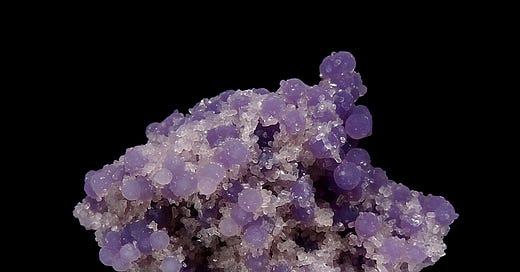So-called "grape agate" from Indonesia is neither grapes (😆) nor agate. So what is it?
Botryoidal Chalcedony (often amethystine): The proper mineralogical term is botryoidal chalcedony. "Botryoidal" means it has a globular, rounded, or "grape-like" external form. Chalcedony is a microcrystalline (or cryptocrystalline) form of quartz. Crucially, the individual crystals of quartz are so small that you can't see them, even with a typical microscope. This is different from, say, a quartz crystal point, where the crystal structure is obvious. Often, the chalcedony is amethystine, meaning it contains trace amounts of iron that give it a purple colour. Sometimes it can be other colours like green or even white.
Not Agate: Agate is a banded form of chalcedony. The banding is caused by subtle changes in the mineral composition or impurities during its formation. “Grape agate" lacks this characteristic banding, so it's simply chalcedony, not agate.
Marketing Term: One person suggested that “Grape Agate” was easier to say and remember than “Grape Chalcedony”!
Below: “Grape Agate”, Mamuju area, Sulawesi Barat Province, Sulawesi, Indonesia. Joe George (aka The Scepter Guy) photo, my specimen. Width about 60mm. The white crystals are calcite.





Seedless/ pipless. No nucleus.
A very attractive specimen Steve.